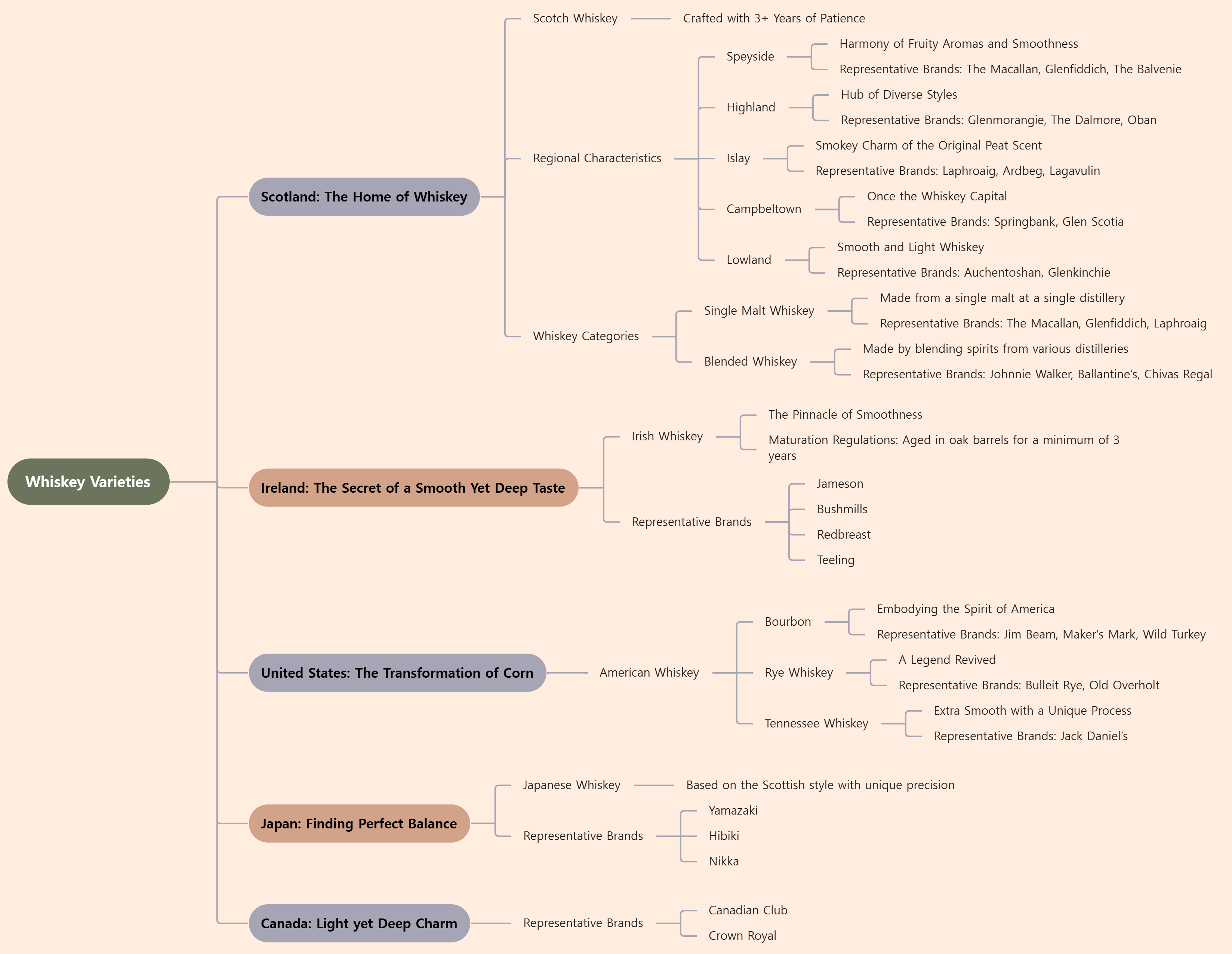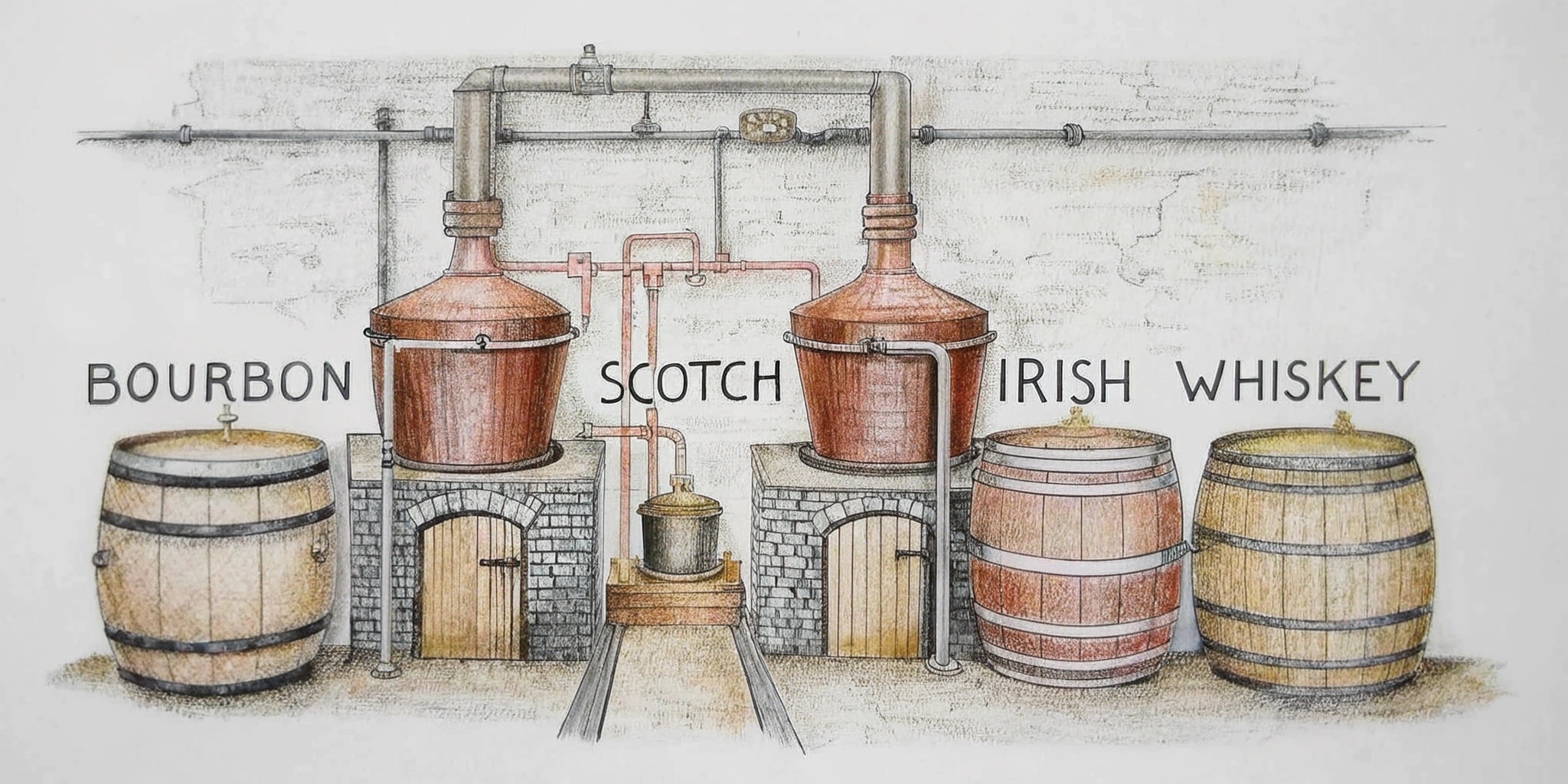Imagine yourself sipping a glass of whiskey, gazing at the clouds drifting past your airplane window. The rich aroma and deep flavor are more than just alcohol; they represent centuries of history and innovation, a culture in itself. How was whiskey born, and how did it develop its unique character in different countries? Today, we’ll explore the origins and evolution of whiskey, and uncover the fascinating stories behind some of the world’s most iconic brands.
Table of Contents
1. Scotland: The Home of Whiskey, Where the Legend Began
The first place that comes to mind when you think of whiskey is undoubtedly Scotland. The very name “whiskey” is derived from the Scottish Gaelic “Uisge Beatha,” meaning “water of life,” a testament to its origins. Legend has it that whiskey began in the 12th century when Irish and Scottish monks learned the art of distillation. In the northern regions, where wine was scarce, monks began distilling grains to create a drink, giving birth to “Uisce Beatha,” the water of life.
Over time, “Uisce” transformed into “Whiskey” or “Whisky,” and this mystical name came to symbolize the value of whiskey, an integral part of life. Embraced by Scotland’s rugged landscape for centuries, this spirit is still referred to as a “legend” today.
Scotland and Ireland have long debated the origins of whiskey. Historically, the term “Whiskey” first appeared in Irish documents in 1405, while whiskey production was mentioned in Scottish tax records in 1494.
However, why is Scotland more renowned for whiskey? Whiskey gained global popularity in the 19th century with the advent of industrialization and mass production. Scotland adapted quickly to industrialization, mass-producing Blended Whiskey and dominating the global market. In contrast, Ireland’s whiskey industry declined due to the Great Famine, Prohibition, and the War of Independence in the late 19th century. These historical factors contributed to Scotland being more widely recognized as the home of whiskey today.
Encountering the Heart of Whiskey in the Misty Isle
Scotland is the heart of whiskey history. The pure water rising from the misty highlands, the barley that thrives even in harsh environments—these are the soul of Scotch Whisky. With 141 distilleries operating as of 2022, Scotland proves that whiskey is not just a drink but a national pride and cultural heritage.
Scotch Whiskey, Crafted with 3+ Years of Patience
While aging in oak barrels, whiskey transforms from a mere liquid into an art form embodying time, history, and nature. From the intensity of Single Malt to the smoothness of Blended and the smokiness of Islay whiskies, Scotch Whiskey possesses a multi-faceted charm.
From the red label of Johnnie Walker to the intense peat of Laphroaig, a sip of whiskey offers an experience like swallowing Scotland’s landscape and history in one go.
Regional Characteristics of Scotch Whiskey
Scotch Whisky possesses distinct personalities and flavors depending on its production region. Regional characteristics are an important criterion for whiskey enthusiasts.
- Speyside: Harmony of Fruity Aromas and Smoothness
- Representative Brands: The Macallan, Glenfiddich, The Balvenie
- Characteristics: Sweet and smooth flavors of dried fruit, honey, and vanilla.
- Highland: Hub of Diverse Styles
- Representative Brands: Glenmorangie, The Dalmore, Oban
- Characteristics: Vary greatly by region, but generally a harmonious blend of smokiness and fruity aromas.
- Islay: The Smokey Charm of the Original Peat Scent
Islay is an island region belonging to Scotland and is completely different from Ireland.The whiskey produced in this region is characterized by a strong smoky flavor and the salty taste of the ocean. The reasons are as follows.Use of peat – Adding a strong smoky scent by using peat as a dry fuel when distilling whiskey.
Proximity to the sea – Seawater penetrates the oak barrels during the aging process, forming a unique marine flavor.
Water containing abundant minerals – One of the factors that determine the deep flavor of whiskey.- Representative Brands: Laphroaig, Ardbeg, Lagavulin
- Representative Brands: Laphroaig, Ardbeg, Lagavulin
- Campbeltown: Once the Whiskey Capital
- Representative Brands: Springbank, Glen Scotia
- Characteristics: Smoky and oily texture
- Lowland: Smooth and Light Whiskey
- Representative Brands: Auchentoshan, Glenkinchie
- Characteristics: Light body and subtle floral aroma
Single Malt vs. Blended Whiskey
Whiskey is broadly divided into two categories:
- Single Malt Whiskey: Made from a single malt at a single distillery.
- Representative Brands: The Macallan, Glenfiddich, Laphroaig
- Blended Whiskey: Made by blending spirits from various distilleries for a balanced taste.
- Representative Brands: Johnnie Walker, Ballantine’s, Chivas Regal
- Representative Brands: Johnnie Walker, Ballantine’s, Chivas Regal
2. Ireland: The Secret of a Smooth Yet Deep Taste
When discussing the history of whiskey, Scotland often comes to mind first. However, Ireland actually boasts an even older tradition. Records show that “Uisce Beatha” (water of life), the origin of the name Whiskey, began around the 12th century when Irish monks spread the art of distillation. In the northern European climate where grape wine production was difficult, they used barley to make alcohol, which became the origin of today’s whiskey.
The most distinctive feature of Irish whiskey is its Triple Distillation process. Unlike Scottish whiskies, which are typically distilled twice, Irish whiskies are distilled a third time for an even smoother finish and cleaner taste. In addition, they rarely use peat, resulting in a more pronounced sweet fruit aroma and creamy texture rather than a smoky scent.
Until the 19th century, Irish whiskey was so popular that it dominated the world market. However, it declined due to Prohibition, the Great Depression, and two World Wars. But since the 1990s, it has been experiencing a resurgence and is now enjoying great popularity worldwide once again.
Irish Whiskey – The Pinnacle of Smoothness
- Key Features: Smooth and creamy texture from triple distillation, a harmonious blend of light fruit and spice.
- Maturation Regulations: Aged in oak barrels for a minimum of 3 years.
Representative Brands:
- Jameson: The best-selling Irish whiskey in the world, with a sweet fruity aroma and smooth texture.
- Bushmills: A representative whiskey produced in Northern Ireland, with a clean malt character.
- Redbreast: Made using the Single Pot Still method, boasting a deep and complex taste.
- Teeling: Modern-style whiskey utilizing various cask finishes.
3. American Whiskey – The Transformation and Untamed Spirit of Corn
Whiskey, having crossed the Atlantic to America, underwent a remarkable evolution in its new environment. Early settlers used distillation techniques brought from Europe to produce rye whiskey, made primarily from rye grain. However, with the abundance of corn in America, a new and distinctive style—bourbon—emerged, ushering in a new era for American whiskey.
Bold and Spicy: Rye Whiskey
Rye whiskey is made with at least 51% rye grain, giving it a signature spicy and dry character. Once the most popular whiskey style in America, it saw a decline during the Prohibition era of the 1920s. However, with the resurgence of cocktail culture, rye whiskey’s bold and unique personality is once again in the spotlight, enjoying a grand revival.
Notable Brands: Bulleit Rye, Russell’s Reserve Rye, Red Black Central Rye
Characteristics: Spicy, with subtle fruity notes and a rich, full-bodied profile
A Perfect Harmony of Vanilla and Caramel: Bourbon
Born in Kentucky, bourbon whiskey is crafted with at least 51% corn, resulting in a smooth and naturally sweet flavor. Aged in new oak barrels, it develops deep vanilla and caramel notes. Matured under the warm southern climate, bourbon embodies the pioneering spirit of America.
Notable Brands: Jim Beam, Maker’s Mark, Wild Turkey
Characteristics: A rich blend of vanilla, caramel, and spice
Extra Smooth with a Unique Process: Tennessee Whiskey
Produced in Tennessee, Tennessee whiskey undergoes the “Lincoln County Process,” a charcoal-mellowing filtration method that enhances its smoothness. Jack Daniel’s, the most well-known Tennessee whiskey, has gained worldwide acclaim and, alongside Kentucky bourbon, remains a leading symbol of American whiskey.
Today, American whiskey continues to honor its traditions while embracing innovation, leading the global market. From bold spices to smooth caramel notes, its timeless appeal continues to captivate whiskey lovers across generations.an innovative spirit that preserves tradition while boldly attempting change.
4. Japan: Finding Perfect Balance
Crossing the Pacific to Japan, whiskey undergoes another beautiful evolution. In 1924, Masataka Taketsuru, who learned distillation techniques in Scotland, opened the era of Japanese whiskey in the 1920s by establishing Nikka and Yamazaki. He respected Scottish traditions while creating a unique whiskey that suited Japan’s climate and natural environment.
Yamazaki, Hakushu, Hibiki, and other Japanese whiskies have captivated whiskey lovers around the world with their delicate and near-perfectly balanced taste. In particular, Yamazaki 12-year-old proudly won a gold medal at international spirits competitions, elevating the status of Japanese whiskey.
Japanese whiskey is based on the Scottish style but adds Japan’s unique precision and delicacy.
- Representative Brands: Yamazaki, Hibiki, Nikka
- Characteristics: Balanced taste and smooth texture are emphasized rather than smoky aromas
In particular, by popularizing a new whiskey style called Highball, it has made it possible to enjoy whiskey more lightly and casually around the world.

5. Canada: Light yet Deep Charm
Canadian whiskey is characterized by a smooth and light style, making it easier to enjoy than American or Scotch. In particular, Rye Whisky is well-developed in Canada, and it has a smoother and sweeter flavor than American Rye Whiskey.
- Representative Brands: Canadian Club, Crown Royal
- Characteristics: Light body and subtle sweetness
Canadian whiskey is especially well-suited to mixed drinks and cocktails, and recently, high-end single malt style Canadian whiskies have also appeared and are being re-evaluated.
The Story in a Glass of Whiskey
Whiskey is not just a drink. From the legend that started in Scotland to the innovation in America, the tradition in Ireland, the sophistication in Japan, and the smoothness in Canada, each sip contains the culture, history, and craftsmanship of the country. It may be a magical liquid that transcends time and space and fully captures human history and culture.
Tonight, why not carefully savor a glass of whiskey and feel the rich story contained within it? Perhaps your whiskey adventure will begin now, at this very moment. ✈️
Whiskey can be broadly categorized into several types based on the ingredients and production methods used.
Single Malt: This type of whiskey is made using only malted barley at a single distillery. It is primarily known for its deep and complex flavors, with Scotland and Japan being the most famous producers. Notable brands include The Macallan, Glenfiddich, and Yamazaki.
Blended Whisky: This whiskey is a mix of malt whiskey and grain whiskey from multiple distilleries, resulting in a balanced flavor profile. Prominent brands in this category are Johnnie Walker, Chivas Regal, and Hibiki.
Bourbon: Mainly produced in the United States, bourbon must contain at least 51% corn. It is characterized by its vanilla and caramel notes. Well-known brands include Jim Beam, Maker’s Mark, and Buffalo Trace.
Rye Whisky: This whiskey has a high proportion of rye grain and is primarily produced in the United States and Canada. It is known for its spicy and dry flavor. Popular brands include Canadian Club and Bulleit Rye.
Irish Whiskey: Known for its smooth and light taste, Irish whiskey is typically triple-distilled. Notable brands include Jameson and Bushmills.


답글 남기기